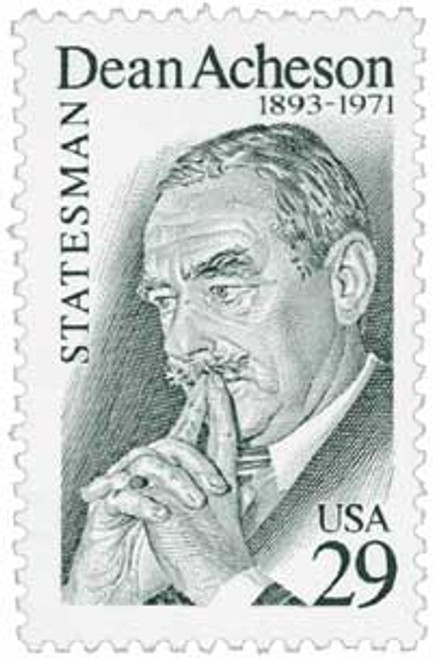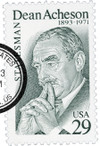
# 2755 - 1993 29c Dean Acheson
U.S. #2755
1993 29¢ Dean Acheson
· Issued to celebrate Dean Acheson’s 100th birthday
· Acheson was the 16th US secretary of state honored on a US stamp
Stamp Category: Commemorative
Value: 29¢
First Day of Issue: April 21, 1993
First Day City: Washington, DC
Quantity Issued: 115,870,000
Printed by: Stamp Venturers
Printing Method: Engraved
Format: Panes of 50 from Intaglio Printing Plates of 300
Perforations: 11.1 x 11.1
Color: Green
Why the stamp was issued: The stamp was issued 10 days after Acheson’s 100th birthday. It had originally been considered for inclusion in the Great Americans definitive series, but was ultimately made a commemorative.
About the stamp design: The stamp was designed by renowned stamp artist Christopher Calle and engraved by the legendary Czeslaw Slania. The portrait on the stamp was based on a photograph taken by George Tames of The New York Times on January 13, 1949. This was during the Senate Foreign Relations Committee’s hearing concerning Acheson’s secretary of state nomination. Calle’s portrait has been praised for its detail and accuracy – realistically depicting his hands (which some artists struggle with) and even the ring on his finger and stripes in his tie.
First Day City: The stamp’s dedication ceremony was held at the Dean Acheson Auditorium within the US State Department Building, in Washington, DC.
History the stamp represents: Dean Gooderham Acheson was born on April 11, 1893, in Middletown, Connecticut. Serving in the State Department for over a decade, he was influential in many of the United States’ World War II and post-war initiatives, including the Lend-Lease Act, Marshall Plan, and NATO.
Acheson went to Groton School, a preparatory boarding school in Massachusetts, before attending Yale College. He then attended Harvard Law School where he was inspired by professor Felix Frankfurter to work harder, and he graduated fifth in his class in 1918.
After Acheson graduated, Frankfurter recommended Supreme Court Justice Louis Brandeis take him on as a clerk. Acheson worked under Brandeis from 1919 to 1921. He then worked at a law firm in Washington, DC, until 1933. At that time, President Franklin Roosevelt made him undersecretary of the Treasury. However, when the secretary became sick, Acheson became acting secretary, and found he didn’t have the knowledge or experience to do the job. Additionally, he disagreed with Roosevelt’s plans to deflate the dollar, so he resigned after less than a year.
Acheson returned to practicing law until 1941, when he was made assistant secretary of state. In that role, he oversaw America’s Lend-Lease operations, providing assistance to Great Britain, as well as a Japanese oil embargo. In 1944, Acheson represented the US State Department at the Bretton Woods Conference, which outlined the world’s economic policies following the war. This meeting led to the creation of the International Monetary Fund, World Bank, and what would become the World Trade Organization.
In 1945, Acheson was made undersecretary of the Department of State, a post he held under Secretaries Edward Stettinius Jr., James F. Byrnes, and George Marshall. The secretaries traveled often, meaning Acheson frequently served as acting secretary. In 1946, he presented the Report on the International Control of Atomic Energy, also known as the Acheson-Lilienthal Plan. The document proposed a plan to prevent nuclear war in the future. Acheson was also instrumental in the creation of the Truman Doctrine, which promised American “support for democracies against authoritarian threats.” Truman presented Acheson with the Medal for Merit in 1947. He also began to implement the Marshall Plan in 1948, which helped Europe recover from World War II. And he negotiated the treaty that led to the creation of the North Atlantic Treaty Organization, or NATO, in 1949.
In 1949, Acheson’s State Department produced a document titled United States Relations with China with Special Reference to the Period 1944-1949, often referred to as the China White Paper. The document was intended to explain how American intervention in China couldn’t succeed, though Acheson’s critics said the document showed how Truman’s administration had allowed communism to spread through China. Though he was a vocal anti-communist, he was accused of not fighting hard enough to take down communism, especially in regard to China.
Acheson resigned from the State Department on Truman’s last day in office, January 20, 1953. He then joined the Yale board of trustees, was a fellow in the American Academy of Arts and Sciences, and returned to practicing law. Practicing out of Washington, DC, he served as an unofficial advisor to Presidents John F. Kennedy, Lyndon B. Johnson, and Richard Nixon. In 1964, Acheson won the Presidential Medal of Freedom and in 1968, he helped to engineer the US withdrawal from the Vietnam conflict. In 1970, he received the Pulitzer Prize for history for Present at the Creation: My Years in the State Department, published in 1969.
Acheson died from a stroke on October 12, 1971.
U.S. #2755
1993 29¢ Dean Acheson
· Issued to celebrate Dean Acheson’s 100th birthday
· Acheson was the 16th US secretary of state honored on a US stamp
Stamp Category: Commemorative
Value: 29¢
First Day of Issue: April 21, 1993
First Day City: Washington, DC
Quantity Issued: 115,870,000
Printed by: Stamp Venturers
Printing Method: Engraved
Format: Panes of 50 from Intaglio Printing Plates of 300
Perforations: 11.1 x 11.1
Color: Green
Why the stamp was issued: The stamp was issued 10 days after Acheson’s 100th birthday. It had originally been considered for inclusion in the Great Americans definitive series, but was ultimately made a commemorative.
About the stamp design: The stamp was designed by renowned stamp artist Christopher Calle and engraved by the legendary Czeslaw Slania. The portrait on the stamp was based on a photograph taken by George Tames of The New York Times on January 13, 1949. This was during the Senate Foreign Relations Committee’s hearing concerning Acheson’s secretary of state nomination. Calle’s portrait has been praised for its detail and accuracy – realistically depicting his hands (which some artists struggle with) and even the ring on his finger and stripes in his tie.
First Day City: The stamp’s dedication ceremony was held at the Dean Acheson Auditorium within the US State Department Building, in Washington, DC.
History the stamp represents: Dean Gooderham Acheson was born on April 11, 1893, in Middletown, Connecticut. Serving in the State Department for over a decade, he was influential in many of the United States’ World War II and post-war initiatives, including the Lend-Lease Act, Marshall Plan, and NATO.
Acheson went to Groton School, a preparatory boarding school in Massachusetts, before attending Yale College. He then attended Harvard Law School where he was inspired by professor Felix Frankfurter to work harder, and he graduated fifth in his class in 1918.
After Acheson graduated, Frankfurter recommended Supreme Court Justice Louis Brandeis take him on as a clerk. Acheson worked under Brandeis from 1919 to 1921. He then worked at a law firm in Washington, DC, until 1933. At that time, President Franklin Roosevelt made him undersecretary of the Treasury. However, when the secretary became sick, Acheson became acting secretary, and found he didn’t have the knowledge or experience to do the job. Additionally, he disagreed with Roosevelt’s plans to deflate the dollar, so he resigned after less than a year.
Acheson returned to practicing law until 1941, when he was made assistant secretary of state. In that role, he oversaw America’s Lend-Lease operations, providing assistance to Great Britain, as well as a Japanese oil embargo. In 1944, Acheson represented the US State Department at the Bretton Woods Conference, which outlined the world’s economic policies following the war. This meeting led to the creation of the International Monetary Fund, World Bank, and what would become the World Trade Organization.
In 1945, Acheson was made undersecretary of the Department of State, a post he held under Secretaries Edward Stettinius Jr., James F. Byrnes, and George Marshall. The secretaries traveled often, meaning Acheson frequently served as acting secretary. In 1946, he presented the Report on the International Control of Atomic Energy, also known as the Acheson-Lilienthal Plan. The document proposed a plan to prevent nuclear war in the future. Acheson was also instrumental in the creation of the Truman Doctrine, which promised American “support for democracies against authoritarian threats.” Truman presented Acheson with the Medal for Merit in 1947. He also began to implement the Marshall Plan in 1948, which helped Europe recover from World War II. And he negotiated the treaty that led to the creation of the North Atlantic Treaty Organization, or NATO, in 1949.
In 1949, Acheson’s State Department produced a document titled United States Relations with China with Special Reference to the Period 1944-1949, often referred to as the China White Paper. The document was intended to explain how American intervention in China couldn’t succeed, though Acheson’s critics said the document showed how Truman’s administration had allowed communism to spread through China. Though he was a vocal anti-communist, he was accused of not fighting hard enough to take down communism, especially in regard to China.
Acheson resigned from the State Department on Truman’s last day in office, January 20, 1953. He then joined the Yale board of trustees, was a fellow in the American Academy of Arts and Sciences, and returned to practicing law. Practicing out of Washington, DC, he served as an unofficial advisor to Presidents John F. Kennedy, Lyndon B. Johnson, and Richard Nixon. In 1964, Acheson won the Presidential Medal of Freedom and in 1968, he helped to engineer the US withdrawal from the Vietnam conflict. In 1970, he received the Pulitzer Prize for history for Present at the Creation: My Years in the State Department, published in 1969.
Acheson died from a stroke on October 12, 1971.











